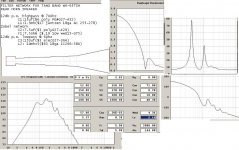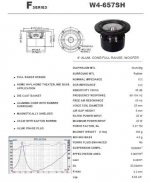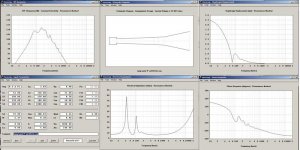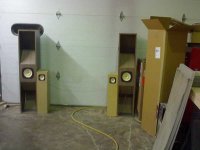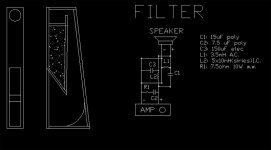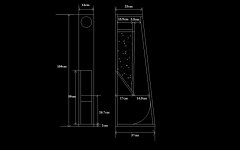I'm not a horn expert (always learning), so I can't make too much of a comment on the design. I can say, though, that it looks like the ultimate in simplicity, go ahead and build a prototype out of MDF and hear the results.
What I can comment on is the x-o layout. For starters, if R1 and C2 are a Zobel, they need to be placed last in the signal chain, immediately before the driver. Plus, if you're going to roll off the top end at 700Hz, a Zobel will not be needed. Second, you have your high and low pass labels reversed (I'm a nitpick, I know). Third, IMO a highpass for this driver is completely unnecessary. A highpass network in this application would be prohibitively expensive, not to mention what it might do to phase. If you're wary of overexcursion, don't be. IME, this driver can handle quite a bit of cone movement (in a standard bass reflex) before the onset of any audible disortion. Lastly, it's a shame to use this driver as just a bass unit. I love the sound of this thing run up as high as 8KHz, rolled off with a simple coil, and handing off the top end to a tiny Dayton Neo with a single cap and resistor. I tried a few different x-o combos with these drivers, and I can say that experimentation will give many different levels of satisfying results. It will be a matter of your taste to determine final values.
I say, build it, and try running the TB way higher than you planned.
BTW, I'm in White Bear Lake. We should audition each other's creations...
What I can comment on is the x-o layout. For starters, if R1 and C2 are a Zobel, they need to be placed last in the signal chain, immediately before the driver. Plus, if you're going to roll off the top end at 700Hz, a Zobel will not be needed. Second, you have your high and low pass labels reversed (I'm a nitpick, I know). Third, IMO a highpass for this driver is completely unnecessary. A highpass network in this application would be prohibitively expensive, not to mention what it might do to phase. If you're wary of overexcursion, don't be. IME, this driver can handle quite a bit of cone movement (in a standard bass reflex) before the onset of any audible disortion. Lastly, it's a shame to use this driver as just a bass unit. I love the sound of this thing run up as high as 8KHz, rolled off with a simple coil, and handing off the top end to a tiny Dayton Neo with a single cap and resistor. I tried a few different x-o combos with these drivers, and I can say that experimentation will give many different levels of satisfying results. It will be a matter of your taste to determine final values.
I say, build it, and try running the TB way higher than you planned.
BTW, I'm in White Bear Lake. We should audition each other's creations...
Not reversed
the high pass and low pass are not reversed. I have a high pass at 700Hz because the Bass response from the horn is almost 20db higher than the direct output from the driver, and the low pass is in place to use the response all the way down to 35hz or so that is above the 88db of the driver. If I only included the highpas the bass would be attenuated below 70hz where as the combination of the filters should give good response from below 40hz all the way up to 16khz making this a very wide range speaker. I wasn't sure where to put the zobel though, so thank you.
the high pass and low pass are not reversed. I have a high pass at 700Hz because the Bass response from the horn is almost 20db higher than the direct output from the driver, and the low pass is in place to use the response all the way down to 35hz or so that is above the 88db of the driver. If I only included the highpas the bass would be attenuated below 70hz where as the combination of the filters should give good response from below 40hz all the way up to 16khz making this a very wide range speaker. I wasn't sure where to put the zobel though, so thank you.
I've never seen it worked out like that. Help me understand- a highpass at 700Hz will pass everything above that point; you'll be (mathematically) 48dB down around 40Hz. A lowpass at 35Hz will pass everyting below that point; you'll be 48dB down at 550Hz. From my understanding, no output below 40Hz and no output above 500Hz will equal essentially no output at all. Explain how it works (I'm not being condiscending, if there's something I'm missing, I want to know).
Are you trying to roll of extra output below a certain point, like a shelving network? If so, a 50uf cap in parallel with a 15 ohm resistor, inserted into the positive leg before the Zobel, would be a good place to start (-10dB @ 70Hz and down, -5dB @ 200Hz, all-pass @ 1KHz). Increase the value of the cap to lower the cutoff points, increase the resistance for greater attenuation.
Without first building the cab, you can't know for sure what the bass output will be. Take it from a guy who used to obsolutely live and die by the numbers. I've been dissapointed so many times by slaving over modelling programs off all different types, building the enclosure or x-o, and finding out the hard way that these programs are tools to help get a person in the neighborhood of what will happen... in-room, with tolerances and numerous other variables. My most successful designs are approached step-by-step. If I were in your shoes, I would build the cab out of cheap material first. Make the CC purposefully oversized and add & subtract mass (wood blocks, tennis balls are nice), line & stuff different areas of the throat, make the curved deflector at the bottom removeable to see if it has an impact on the amount of midbass coming from the mouth, and consider a suprabaffle. After a few different combinations are experienced, then start implementing a shelving network. Hell, even inserting the tweeter has an impact on perceived low frequency output. The journey can be tedious, but it's more rewarding than spending north of $100 in x-o equipment that might not be necessary and you'll be too temped to use. Buff out the sound, then go for the nice wood (or not), and proudly announce your accomplishments.
BTW, your profile (I thought) previousely said you were in River Falls. Cloquet isn't exactly close to White Bear.
Are you trying to roll of extra output below a certain point, like a shelving network? If so, a 50uf cap in parallel with a 15 ohm resistor, inserted into the positive leg before the Zobel, would be a good place to start (-10dB @ 70Hz and down, -5dB @ 200Hz, all-pass @ 1KHz). Increase the value of the cap to lower the cutoff points, increase the resistance for greater attenuation.
Without first building the cab, you can't know for sure what the bass output will be. Take it from a guy who used to obsolutely live and die by the numbers. I've been dissapointed so many times by slaving over modelling programs off all different types, building the enclosure or x-o, and finding out the hard way that these programs are tools to help get a person in the neighborhood of what will happen... in-room, with tolerances and numerous other variables. My most successful designs are approached step-by-step. If I were in your shoes, I would build the cab out of cheap material first. Make the CC purposefully oversized and add & subtract mass (wood blocks, tennis balls are nice), line & stuff different areas of the throat, make the curved deflector at the bottom removeable to see if it has an impact on the amount of midbass coming from the mouth, and consider a suprabaffle. After a few different combinations are experienced, then start implementing a shelving network. Hell, even inserting the tweeter has an impact on perceived low frequency output. The journey can be tedious, but it's more rewarding than spending north of $100 in x-o equipment that might not be necessary and you'll be too temped to use. Buff out the sound, then go for the nice wood (or not), and proudly announce your accomplishments.
BTW, your profile (I thought) previousely said you were in River Falls. Cloquet isn't exactly close to White Bear.
I lived in River Falls till February I then I moved back to Cloquet. Actually with the 12db per octave high pass at 700Hz I'll be down 24db down at 175Hz, with the low pass at 60Hz (not 35 like you said) I'll be down 24db at 240Hz. The two circuits are run parallel not series, with the middle being 107.5 hz down about 20 db which is right where I need it. The slopes combine with the output from the front of the driver and the output of the horn (180 degrees out of phase because it's coming out the back and reflecting off the wall) to form a relitively flat response from 40hz up to 16khz. All theoretic of course but figuring is fun. Obviously I plan to build the box and make tweeks and adjustments before measuring the actual response so as to correctly design the filter, but I just wanted to see what was possible and check with some of the experts here and see if I'm calculating correctly in the first place or if I was doing something way off. The biggest question I have is whether the response out of the horn will really be way up at 110db. It seems unlikely to me but I don't know, I just learning this stuff. the two rear loaded horn systems my friend and I built this summer from plans we found on the internet sound amazing and I wanted to come up with a design of my own to possibly sell so I'm working it out in my head right now because I don't have money to actually make anything at the moment.
Attachments
maybe the horn should come out the front
I just realized that if the horn shifts the phase and then the filter shifts it as well I should probably have the horn come out the front. I think I should have put a more attention grabbing title on this thread.
I just realized that if the horn shifts the phase and then the filter shifts it as well I should probably have the horn come out the front. I think I should have put a more attention grabbing title on this thread.
Figuring and crunching numbers is fun, it's the best substitute when lack of funds means no building. I didn't know that you had some experience with building. My comments on tweaking were more geared for someone with undeveloped skills. I still don't fully understand the filter, but that's not unusual, especially if it's an established topology that I simply haven't seen before. I don't own this particular driver anymore, but I do have the W4-654 on hand. I would be willing to build a test mule (I've got some spare time and an itchy trigger finger) if you were unable. I'm always looking for a simple build. Let me know the dimensions by e-mail, and I'll see what happens, maybe by the weekend. I need another project to add to the five or so unfinished ones I already have...
That would be sweet
If you have Autocad I could send the original drawing. Otherwise I could draw one up with the dimensions and send you a jpg. Let me know which works for you.
If you have Autocad I could send the original drawing. Otherwise I could draw one up with the dimensions and send you a jpg. Let me know which works for you.
BSC incorporated in filter ?
I was wondering in you had considered the baffle step loss when designing your filter. The horn baffle width is fairly narrow so there will be quite a bit of baffle step loss, you may want to keep some of the low end to compensate instead of rolling it off in a low pass filter.
I was wondering in you had considered the baffle step loss when designing your filter. The horn baffle width is fairly narrow so there will be quite a bit of baffle step loss, you may want to keep some of the low end to compensate instead of rolling it off in a low pass filter.
I don't have Autocad, so a jpeg w/ dims would be preferred. If you happened to play around with Hornresp and seen responses for more than one set of numbers, make a note of it or supply an acceptable tolerence on dims. As said before, I'm an experimentor. Thanks for the opportunity.
PJN:
Like I said I plan to build it first and test actual response before actually building the filter. I spelled out the components mainly to get an idea what it would cost, and to keep my mind sharp. and I really don't know much about BSC so I haven't really figured it out. I should do a little research on that subject as I would like to design and build speaker systems, studio monitors, and home theater systems to sell some day. There's so much to learn and so little time.
Like I said I plan to build it first and test actual response before actually building the filter. I spelled out the components mainly to get an idea what it would cost, and to keep my mind sharp. and I really don't know much about BSC so I haven't really figured it out. I should do a little research on that subject as I would like to design and build speaker systems, studio monitors, and home theater systems to sell some day. There's so much to learn and so little time.
Ping brsanko, I'm lookin' forward to having something different to listen to on Sunday. It's gonna be Dayton PA130s on open baffles out of solid walnut someone gave to me (lean sounding), or auditioning 3 different 4"ers in a RLH if you will supply the drawings...
As you can see this drawingis vastly different than the first one but the response is very similar. So all dimensions are pretty noncritical with the possible exception of the compression chamber size. So feel free to make some changes to accomodate ease of construction or other factors.
If my simulations are correct it should sound pretty boomy without the filter, so don't be disappointed if it does. but if it sounds good as is that's not a bad thing either.
I'm not expecting miraculous sound. I just want play around with something simple. I've got some spare caps & coils laying around (although nowhere near the values your filter is calling for), so I can mess around at least a little. Thanks a lot, I'll report back.
BTW- wood thickness?
BTW- wood thickness?
- Status
- Not open for further replies.
- Home
- Loudspeakers
- Full Range
- Tb W4-657 Rlh

